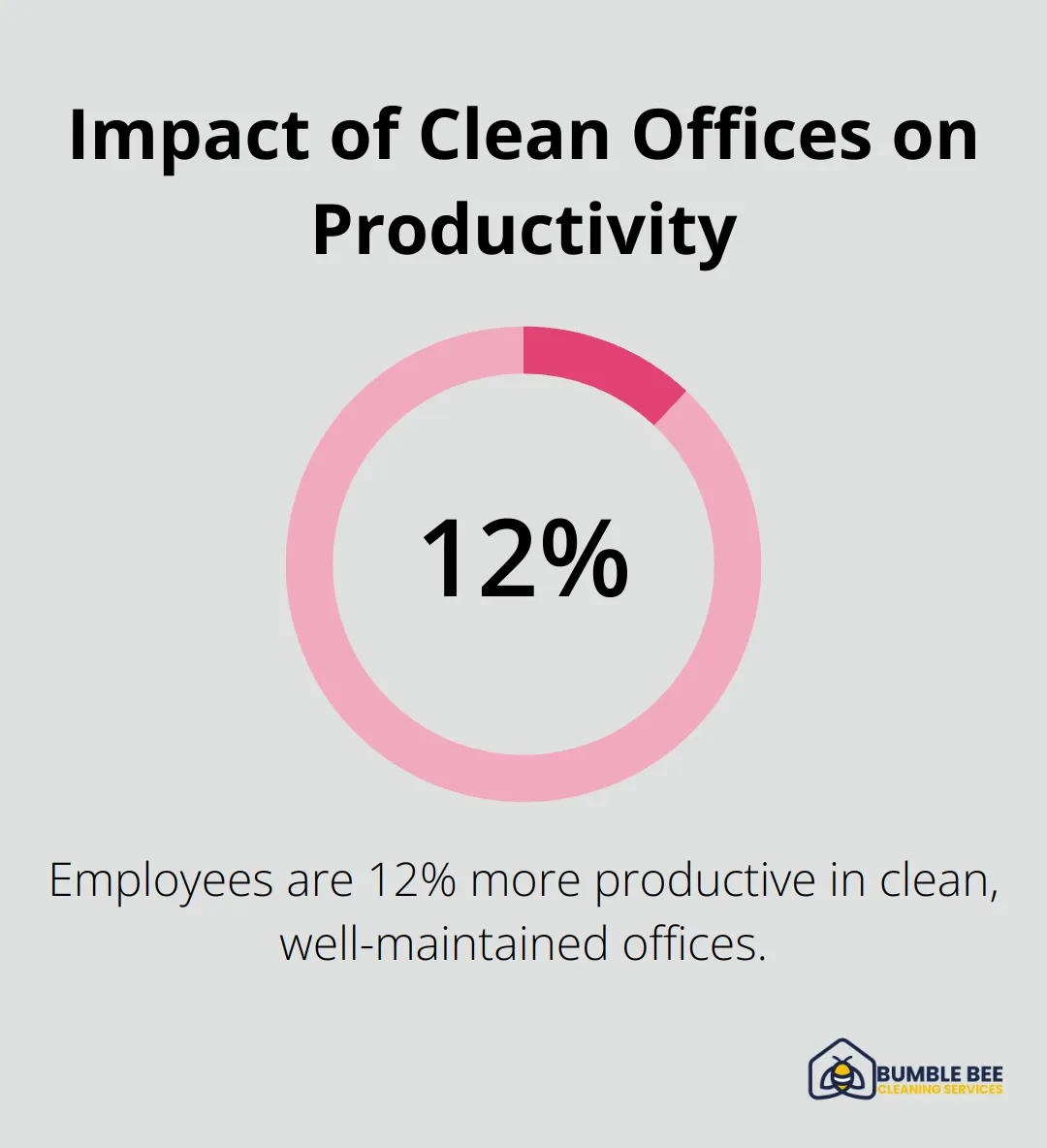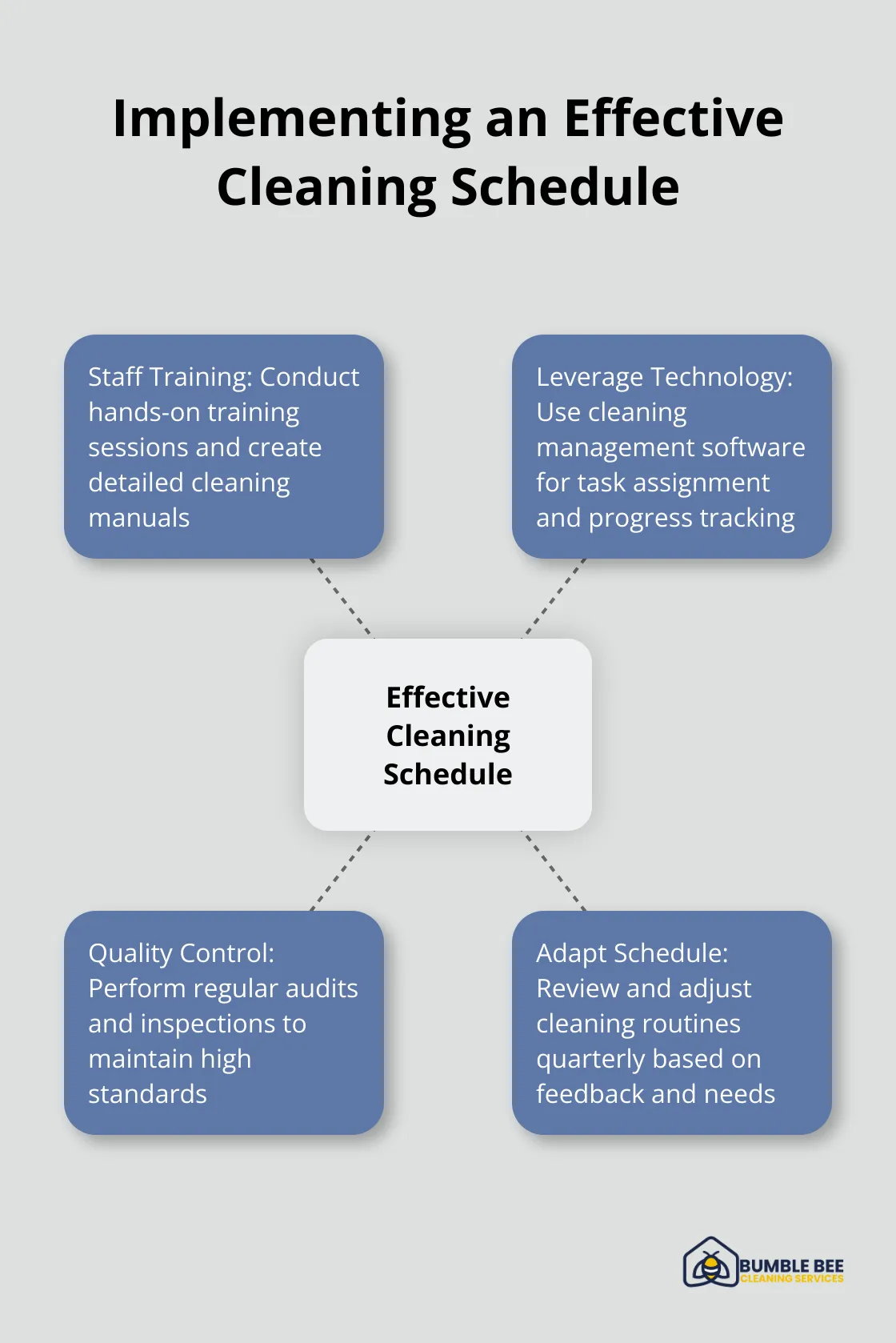At Bumble Bee Cleaning Services, we understand the challenges Seattle businesses face in maintaining a clean and productive environment. Efficient cleaning schedules are the backbone of effective janitorial management, directly impacting your bottom line and reputation.
In this post, we’ll explore how to create and implement cleaning routines that boost productivity, enhance customer experiences, and ensure compliance with local regulations. We’ll also share practical tips to help you optimize your cleaning processes and maximize the benefits for your Seattle-based business.
Why Efficient Cleaning Matters for Seattle Businesses
Productivity and Morale Boost
A clean workspace propels productivity. Research indicates that employees working in clean and well-maintained offices are 12% more productive. This translates to real benefits for Seattle businesses. A local tech startup (not affiliated with Bumble Bee Cleaning Services) reported a 7% increase in task completion rates after they implemented a structured cleaning schedule.

Clean offices also contribute to employee satisfaction. The International Facility Management Association found that 90% of employees believe a clean workspace helps them perform better. This improved morale can reduce absenteeism and lower turnover rates, which saves businesses significant recruitment and training costs.
Customer Perception Elevation
First impressions count, especially in customer-facing businesses. A spotless environment signals professionalism and attention to detail. The National Retail Federation reports that 64% of customers have left a store due to its appearance. In Seattle’s competitive market, a clean space can make the difference between gaining a loyal customer and losing business to a competitor.
Cost Optimization Through Smart Resource Allocation
Efficient cleaning schedules aren’t just about cleanliness; they represent smart resource management. Businesses can reduce unnecessary labor costs by identifying high-traffic areas and focusing efforts where they’re most needed. A Seattle-based restaurant chain (not associated with Bumble Bee Cleaning Services) reported a 15% reduction in cleaning expenses after they implemented a data-driven cleaning schedule.
Regulatory Compliance Assurance
Seattle enforces strict health and safety regulations, particularly for food service and healthcare industries. Regular, documented cleaning schedules are essential for passing inspections and avoiding costly fines. In 2022, more than 1.7 million pounds of hazardous materials were safely disposed of in King County, protecting both the environment and public health.
Healthier Work Environment Promotion
In Seattle’s often damp climate, efficient cleaning is vital for maintaining indoor air quality and preventing mold growth. The American Lung Association reports that poor indoor air quality can decrease productivity by 9%. Regular cleaning, especially with HEPA-filtered equipment, can significantly reduce allergens and improve overall workplace health.
As we move forward, let’s explore how to create an effective cleaning schedule that addresses these critical aspects and tailors to your business’s unique needs.
How to Create a Tailored Cleaning Schedule
Assess Your Business’s Cleaning Requirements
Start with a thorough assessment of your premises. Walk through each area and note specific cleaning needs. A Seattle coffee shop might require hourly bathroom checks and counter wipe-downs, while an office space might focus more on weekly carpet vacuuming and daily trash removal.
Consider factors like foot traffic, type of business, and seasonal changes. Seattle’s rainy season often leads to more frequent entryway cleaning. The Washington State Department of Health recommends daily sanitization of high-touch surfaces in public spaces to prevent the spread of illnesses.
Prioritize High-Traffic and Critical Areas
Identify the areas in your business that see the most use or are critical to operations. These typically include:
- Entryways and lobbies
- Restrooms
- Break rooms and kitchens
- Conference rooms
- Customer service areas
Seattle’s home cleaning techniques stand out in both effectiveness and sustainability, attributable to their unique blend of eco-friendly products and innovative methods.
Determine Optimal Cleaning Frequencies
Different areas and tasks require varying cleaning frequencies. Here’s a general guideline:
Daily tasks: Empty trash, wipe down surfaces, mop floors in high-traffic areas.Weekly tasks: Thoroughly vacuum, dust, and disinfect less-used areas.Monthly tasks: Deep clean carpets, wash windows, sanitize office equipment.
The Centers for Disease Control and Prevention recommends cleaning high-touch surfaces at least once a day. However, busy Seattle businesses might need to increase this frequency.

Allocate Resources Efficiently
Efficient resource allocation maintains cleanliness without breaking the bank. Consider these strategies:
- Time your cleaning tasks: Track how long each task takes to better allocate staff hours.
- Invest in quality equipment: High-efficiency vacuums and microfiber cloths can reduce cleaning time by up to 30%.
- Train staff properly: Well-trained cleaners work more efficiently. The International Janitorial Cleaning Services Association reports that proper training can increase productivity by 25%.
- Use a cleaning checklist: This ensures no tasks are missed and allows for easy quality control.
Adapt and Refine Your Schedule
An effective cleaning schedule evolves with your business needs. Regular reviews and adjustments based on feedback and changing requirements are essential. Try to involve your staff in this process, as they often have valuable insights into daily cleaning challenges.
(Pro tip: Consider using digital tools to manage your cleaning schedule. Many apps can help track tasks, assign responsibilities, and generate reports.)
The next step in mastering efficient cleaning schedules involves implementing and maintaining your newly created plan. Let’s explore how to put your schedule into action and ensure its long-term success.
How to Put Your Cleaning Schedule into Action
Staff Training: The Foundation of Success
Effective implementation starts with thorough staff training. Create detailed cleaning manuals and conduct hands-on training sessions. These should cover proper use of equipment, safety protocols, and the specifics of your new schedule.
Well-trained cleaning staff can lead to enhanced cleaning performance, reduced workplace risks, improved job satisfaction, and a competitive edge in Seattle’s business environment. They also contribute to creating healthier work environments.
Leverage Technology for Enhanced Management
Modern cleaning management software can significantly improve schedule adherence and task tracking. Digital technology streamlines housekeeping tasks, improving efficiency and saving time. Automated systems help schedule cleaning tasks, enhancing overall management.
Apps like Swept and CleanTelligent allow real-time task assignment, progress tracking, and instant communication between team members.
Quality Control: Maintaining High Standards
Regular audits and inspections are essential for maintaining high cleaning standards. The American Society for Quality recommends weekly spot checks and monthly thorough inspections.
Use a standardized checklist for these audits. This ensures consistency and allows for easy tracking of improvements over time. Many businesses have found success with the APPA Custodial Staffing Guidelines, which provide a five-level quality system for assessing cleanliness.
Adapt Your Schedule to Changing Needs
Your cleaning schedule should evolve with your business needs. The Cleaning Management Institute advises reviewing and adjusting schedules quarterly.
Pay attention to feedback from staff and customers.
Consider seasonal changes as well. Many Seattle businesses increase entryway cleaning frequency during the rainy season to prevent slip hazards and maintain a professional appearance.

An efficient cleaning schedule optimizes your business operations. Focus on these key areas to ensure your new cleaning routine delivers maximum value for your Seattle business.
Final Thoughts
Efficient cleaning schedules form the foundation of successful janitorial management for Seattle businesses. Companies that implement well-structured cleaning routines experience improved productivity, enhanced customer experiences, and regulatory compliance. These advantages extend far beyond a tidy workspace, leading to healthier work environments, reduced employee absenteeism, and lower turnover rates.
A positive brand image, increased customer loyalty, and the potential to attract new clients result from meticulously maintained environments. Smart resource allocation and reduced waste can significantly impact a company’s bottom line over time. The long-term effects of an optimized cleaning schedule on Seattle businesses prove substantial and far-reaching.
We at Bumble Bee Cleaning Services offer comprehensive cleaning solutions tailored to each client’s specific needs. Our team of certified experts uses eco-friendly products that align with Seattle’s commitment to sustainability. Seattle businesses can focus on their core operations while we ensure their spaces remain spotless and inviting (with our 100% quality service guarantee).
